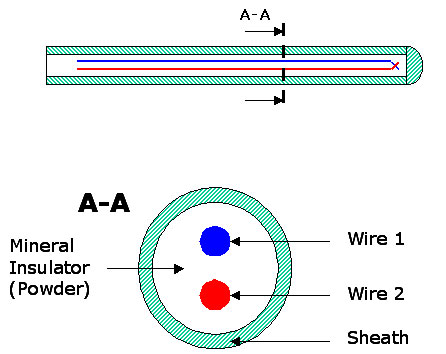THERMOCOUPLE CONFIGURATIONS: BARE WIRES AND MIMS
The simplest thermocouple is made using a bare wire configuration, that is two thermoelements joined at one end and directly exposed to the atmosphere of the operating environment. The operating environment can be an oxidizing, reducing or inert atmosphere and constrains on the use of thermoelements in some atmospheres can exist because of lack of compatibility between the materials the thermoelements are made of and the gases. For instance W/W-Re thermocouples cannot be used in oxidizing atmosphere because, above 600°C, tungsten reacts easily with oxygen producing volatile oxides: the thermoelements can be rapidly damaged and fail.
The MIMS (Mineral Insulated Metal Sheathed) configuration can overcome the problems arising from the interaction between thermoelements and atmosphere: the thermoelements are protected from the environment using a metallic sheath; between the thermoelements and the sheath a ceramic material provides electrical insulation. Figure7 shows longitudinal and cross sections of a MIMS thermocouple.
|
| Figure7: Longitudinal and cross section for MIMS thermocouple |
Even though protection of the wires can be achieved with MIMS configuration, the time response of MIMS thermocouples to change in the temperature of the operating environment is slower than bare wire configurations.
|
